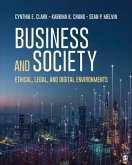Ana Cristina Siqueira, Cristina Neesham, Nancy E Landrum, Patricia Kanashiro
Sustainability Management
A Systems Approach
Ana Cristina Siqueira, Cristina Neesham, Nancy E Landrum, Patricia Kanashiro
Sustainability Management
A Systems Approach
- Broschiertes Buch
- Merkliste
- Auf die Merkliste
- Bewerten Bewerten
- Teilen
- Produkt teilen
- Produkterinnerung
- Produkterinnerung
Sustainability Management: A Systems Approach is an indispensable guide for students and professionals seeking to understand and implement sustainable business practices. The book explores the interconnectedness of natural ecosystems, societies, organizations, and individuals, offering a holistic approach to sustainability management that aligns economic, social, and environmental goals.
Andere Kunden interessierten sich auch für
![Business and Society Business and Society]() Cynthia E ClarkBusiness and Society229,99 €
Cynthia E ClarkBusiness and Society229,99 €![Business and Society Business and Society]() Cynthia E ClarkBusiness and Society227,99 €
Cynthia E ClarkBusiness and Society227,99 €![Fundamentals of Human Resource Management Fundamentals of Human Resource Management]() Robert N LussierFundamentals of Human Resource Management190,99 €
Robert N LussierFundamentals of Human Resource Management190,99 €![Compensation Compensation]() Beverly J DemarrCompensation131,99 €
Beverly J DemarrCompensation131,99 €![Human Resource Management Human Resource Management]() Talya BauerHuman Resource Management225,99 €
Talya BauerHuman Resource Management225,99 €![Effective Training Effective Training]() P Nick BlanchardEffective Training192,99 €
P Nick BlanchardEffective Training192,99 €![Supply Chain Management Supply Chain Management]() Ray R VenkataramanSupply Chain Management225,99 €
Ray R VenkataramanSupply Chain Management225,99 €-
-
-
Sustainability Management: A Systems Approach is an indispensable guide for students and professionals seeking to understand and implement sustainable business practices. The book explores the interconnectedness of natural ecosystems, societies, organizations, and individuals, offering a holistic approach to sustainability management that aligns economic, social, and environmental goals.
Hinweis: Dieser Artikel kann nur an eine deutsche Lieferadresse ausgeliefert werden.
Hinweis: Dieser Artikel kann nur an eine deutsche Lieferadresse ausgeliefert werden.
Produktdetails
- Produktdetails
- Verlag: Sage Publications
- Seitenzahl: 568
- Erscheinungstermin: 13. März 2025
- Englisch
- ISBN-13: 9781071876879
- ISBN-10: 1071876872
- Artikelnr.: 71870350
- Herstellerkennzeichnung
- Libri GmbH
- Europaallee 1
- 36244 Bad Hersfeld
- gpsr@libri.de
- Verlag: Sage Publications
- Seitenzahl: 568
- Erscheinungstermin: 13. März 2025
- Englisch
- ISBN-13: 9781071876879
- ISBN-10: 1071876872
- Artikelnr.: 71870350
- Herstellerkennzeichnung
- Libri GmbH
- Europaallee 1
- 36244 Bad Hersfeld
- gpsr@libri.de
Ana Cristina O. Siqueira (PhD, University of Cambridge) is Professor of Management, and Director of the Center for Socially Responsible Entrepreneurship and Innovation at the Cotsakos College of Business, William Paterson University. Her articles have appeared in premier publications such as Journal of Business Ethics, Entrepreneurship Theory and Practice, and Journal of Business Venturing. She received Social Entrepreneurship Special Interest Group Awards for Excellence in Practice and Service in 2022 and for Excellence in Scholarship in 2024 from the United States Association for Small Business and Entrepreneurship. She also received a 2024 Publication of the Year Award by B Academics, a global community working to advance research on socially and environmentally responsible businesses. She is an Editorial Board Member at Entrepreneurship Theory & Practice and Associated Editor at the Journal of Business Venturing Insights.
Preface
Acknowledgments
About The Authors
Chapter 1: Introduction to Sustainability Management: Theory
What is Sustainability Management?
A Systems Approach to Sustainability Management
Summary
Discussion Questions
Chapter 2: Introduction to Sustainability Management: Practice
Challenges to Global Sustainability
Opportunities for Global Sustainability
Summary
Discussion Questions
Chapter 3: Institutions and Sustainability Management
Institutional Theory and Sustainability Management
Businesses and Institutions
Reasons Why Businesses Comply with Institutional Pressures
Strategic Responses to Institutional Pressures
Greenwashing and Beyond
Summary
Discussion Questions
Chapter 4: Stakeholders and Sustainability Management
Stakeholder Theory
Stakeholder Management
Responsibilities to Stakeholders
Stakeholder Engagement
Summary
Discussion Questions
Chapter 5: Resources, Capabilities, and Strategies for Sustainability
Shared Value and Sustainability
Integrating Sustainability into the Overall Corporate Strategy
Resource-Based View and Sustainability
Adaptability, Consumer Benefits, and Sustainability
Prioritizing Actions by Coordinating Ecosystems
Summary
Discussion Questions
Chapter 6: Innovation and Entrepreneurship for Sustainability
Creativity, Innovation, and Entrepreneurial Ingenuity for Sustainability
Entrepreneurship in the Circular Economy
Voluntary Ethical Standards and Sustainable Entrepreneurial Ingenuity
Business Models and Sustainability
Technology for Sustainability Goals
Summary
Discussion Questions
Appendix: The Socially Responsible Business Model
Chapter 7: Formulating Corporate Strategies: Alliances and Global Supply
Chains
Alliances and Partnerships
Mergers and Acquisitions
Global Supply Chains and International Alliances
Host versus Home Countries Corporate Strategies
Summary
Discussion Questions
Chapter 8: Implementing Environmental, Social, and Governance Strategies
Agency Theory: The Role of Monitoring and Incentives in Sustainability
Management
Monitoring Sustainability Performance: Greening the Boardroom
Incentives for Sustainability: Greening the Executive Compensation
Shareholder Activism for Sustainability management
The Special Case of the Chief Sustainability Officer
Summary
Discussion Questions
Chapter 9: Monitoring and Measuring Environmental, Social, and Governance
Performance
The Origins of ESG
Sustainability, ESG, and Related Concepts
ESG Ratings, Criteria, and Metrics
ESG Metrics, Standards, and Frameworks
ESG Challenges
Summary
Discussion Questions
Chapter 10: Diversity, Equity, and Inclusion in the Context of
Sustainability
Diversity, equity, and inclusion as part of Corporate Social Responsibility
Racial Diversity in Organizations
Gender Inclusion and Corporate Social Responsibility
New Technologies and Ethics
The Strategic Role of Diversity, Equity, and Inclusion
Summary
Discussion Questions
Chapter 11: Sustainability Reporting Frameworks and Standards
History of Companies Transparency and Accountability
Materiality as a Guiding Principle for Financial and Non-Financial
Disclosures
Benefits and Challenges of Sustainability Disclosure
Best Practices and Trends in Sustainability Reporting
Summary
Discussion Questions
CASE 1: hiLyte and the Commercialization of Sustainable Technology1
CASE 2: The Mae Fah Luang Foundation: Circular Strategy in Coffee
Production1
CASE 3: FabricAID: Circular Economy in the Fashion Industry
CASE 4: Farm Animal Welfare Reporting: Using Investor Benchmarks to Change
Corporate Behaviour
CASE 5: Occidental of Colombia and Indigenous People's Rights: The Right to
Free, Prior, and Informed Consent
CASE 6: Polestar 0 Project: Introducing a Climate-Neutral Vehicle
CASE 7: Christian Dior Couture: Luxury Fashion, Feminism and SDG5
CASE 8: Bhoomi Diapers: Creating Eco-Friendly Products
CASE 9: Taos Ski Valley: A Systems Perspective on Sustainability Strategy
CASE 10: Vegadona: User-Generated Content For Vegans
CASE 11: Thread International: Attempting a Takeback Program and Its
Sustainability Challenges
CASE 12: Machu Picchu, a Carbon-Neutral World Wonder
CASE 13: Loyola University Chicago: Becoming a Leader of Environmental
Sustainability
CASE 14: Tesla, the Global Electric Vehicle Industry, and the Future of
Patented Technologies
Glossary
Acknowledgments
About The Authors
Chapter 1: Introduction to Sustainability Management: Theory
What is Sustainability Management?
A Systems Approach to Sustainability Management
Summary
Discussion Questions
Chapter 2: Introduction to Sustainability Management: Practice
Challenges to Global Sustainability
Opportunities for Global Sustainability
Summary
Discussion Questions
Chapter 3: Institutions and Sustainability Management
Institutional Theory and Sustainability Management
Businesses and Institutions
Reasons Why Businesses Comply with Institutional Pressures
Strategic Responses to Institutional Pressures
Greenwashing and Beyond
Summary
Discussion Questions
Chapter 4: Stakeholders and Sustainability Management
Stakeholder Theory
Stakeholder Management
Responsibilities to Stakeholders
Stakeholder Engagement
Summary
Discussion Questions
Chapter 5: Resources, Capabilities, and Strategies for Sustainability
Shared Value and Sustainability
Integrating Sustainability into the Overall Corporate Strategy
Resource-Based View and Sustainability
Adaptability, Consumer Benefits, and Sustainability
Prioritizing Actions by Coordinating Ecosystems
Summary
Discussion Questions
Chapter 6: Innovation and Entrepreneurship for Sustainability
Creativity, Innovation, and Entrepreneurial Ingenuity for Sustainability
Entrepreneurship in the Circular Economy
Voluntary Ethical Standards and Sustainable Entrepreneurial Ingenuity
Business Models and Sustainability
Technology for Sustainability Goals
Summary
Discussion Questions
Appendix: The Socially Responsible Business Model
Chapter 7: Formulating Corporate Strategies: Alliances and Global Supply
Chains
Alliances and Partnerships
Mergers and Acquisitions
Global Supply Chains and International Alliances
Host versus Home Countries Corporate Strategies
Summary
Discussion Questions
Chapter 8: Implementing Environmental, Social, and Governance Strategies
Agency Theory: The Role of Monitoring and Incentives in Sustainability
Management
Monitoring Sustainability Performance: Greening the Boardroom
Incentives for Sustainability: Greening the Executive Compensation
Shareholder Activism for Sustainability management
The Special Case of the Chief Sustainability Officer
Summary
Discussion Questions
Chapter 9: Monitoring and Measuring Environmental, Social, and Governance
Performance
The Origins of ESG
Sustainability, ESG, and Related Concepts
ESG Ratings, Criteria, and Metrics
ESG Metrics, Standards, and Frameworks
ESG Challenges
Summary
Discussion Questions
Chapter 10: Diversity, Equity, and Inclusion in the Context of
Sustainability
Diversity, equity, and inclusion as part of Corporate Social Responsibility
Racial Diversity in Organizations
Gender Inclusion and Corporate Social Responsibility
New Technologies and Ethics
The Strategic Role of Diversity, Equity, and Inclusion
Summary
Discussion Questions
Chapter 11: Sustainability Reporting Frameworks and Standards
History of Companies Transparency and Accountability
Materiality as a Guiding Principle for Financial and Non-Financial
Disclosures
Benefits and Challenges of Sustainability Disclosure
Best Practices and Trends in Sustainability Reporting
Summary
Discussion Questions
CASE 1: hiLyte and the Commercialization of Sustainable Technology1
CASE 2: The Mae Fah Luang Foundation: Circular Strategy in Coffee
Production1
CASE 3: FabricAID: Circular Economy in the Fashion Industry
CASE 4: Farm Animal Welfare Reporting: Using Investor Benchmarks to Change
Corporate Behaviour
CASE 5: Occidental of Colombia and Indigenous People's Rights: The Right to
Free, Prior, and Informed Consent
CASE 6: Polestar 0 Project: Introducing a Climate-Neutral Vehicle
CASE 7: Christian Dior Couture: Luxury Fashion, Feminism and SDG5
CASE 8: Bhoomi Diapers: Creating Eco-Friendly Products
CASE 9: Taos Ski Valley: A Systems Perspective on Sustainability Strategy
CASE 10: Vegadona: User-Generated Content For Vegans
CASE 11: Thread International: Attempting a Takeback Program and Its
Sustainability Challenges
CASE 12: Machu Picchu, a Carbon-Neutral World Wonder
CASE 13: Loyola University Chicago: Becoming a Leader of Environmental
Sustainability
CASE 14: Tesla, the Global Electric Vehicle Industry, and the Future of
Patented Technologies
Glossary
Preface
Acknowledgments
About The Authors
Chapter 1: Introduction to Sustainability Management: Theory
What is Sustainability Management?
A Systems Approach to Sustainability Management
Summary
Discussion Questions
Chapter 2: Introduction to Sustainability Management: Practice
Challenges to Global Sustainability
Opportunities for Global Sustainability
Summary
Discussion Questions
Chapter 3: Institutions and Sustainability Management
Institutional Theory and Sustainability Management
Businesses and Institutions
Reasons Why Businesses Comply with Institutional Pressures
Strategic Responses to Institutional Pressures
Greenwashing and Beyond
Summary
Discussion Questions
Chapter 4: Stakeholders and Sustainability Management
Stakeholder Theory
Stakeholder Management
Responsibilities to Stakeholders
Stakeholder Engagement
Summary
Discussion Questions
Chapter 5: Resources, Capabilities, and Strategies for Sustainability
Shared Value and Sustainability
Integrating Sustainability into the Overall Corporate Strategy
Resource-Based View and Sustainability
Adaptability, Consumer Benefits, and Sustainability
Prioritizing Actions by Coordinating Ecosystems
Summary
Discussion Questions
Chapter 6: Innovation and Entrepreneurship for Sustainability
Creativity, Innovation, and Entrepreneurial Ingenuity for Sustainability
Entrepreneurship in the Circular Economy
Voluntary Ethical Standards and Sustainable Entrepreneurial Ingenuity
Business Models and Sustainability
Technology for Sustainability Goals
Summary
Discussion Questions
Appendix: The Socially Responsible Business Model
Chapter 7: Formulating Corporate Strategies: Alliances and Global Supply
Chains
Alliances and Partnerships
Mergers and Acquisitions
Global Supply Chains and International Alliances
Host versus Home Countries Corporate Strategies
Summary
Discussion Questions
Chapter 8: Implementing Environmental, Social, and Governance Strategies
Agency Theory: The Role of Monitoring and Incentives in Sustainability
Management
Monitoring Sustainability Performance: Greening the Boardroom
Incentives for Sustainability: Greening the Executive Compensation
Shareholder Activism for Sustainability management
The Special Case of the Chief Sustainability Officer
Summary
Discussion Questions
Chapter 9: Monitoring and Measuring Environmental, Social, and Governance
Performance
The Origins of ESG
Sustainability, ESG, and Related Concepts
ESG Ratings, Criteria, and Metrics
ESG Metrics, Standards, and Frameworks
ESG Challenges
Summary
Discussion Questions
Chapter 10: Diversity, Equity, and Inclusion in the Context of
Sustainability
Diversity, equity, and inclusion as part of Corporate Social Responsibility
Racial Diversity in Organizations
Gender Inclusion and Corporate Social Responsibility
New Technologies and Ethics
The Strategic Role of Diversity, Equity, and Inclusion
Summary
Discussion Questions
Chapter 11: Sustainability Reporting Frameworks and Standards
History of Companies Transparency and Accountability
Materiality as a Guiding Principle for Financial and Non-Financial
Disclosures
Benefits and Challenges of Sustainability Disclosure
Best Practices and Trends in Sustainability Reporting
Summary
Discussion Questions
CASE 1: hiLyte and the Commercialization of Sustainable Technology1
CASE 2: The Mae Fah Luang Foundation: Circular Strategy in Coffee
Production1
CASE 3: FabricAID: Circular Economy in the Fashion Industry
CASE 4: Farm Animal Welfare Reporting: Using Investor Benchmarks to Change
Corporate Behaviour
CASE 5: Occidental of Colombia and Indigenous People's Rights: The Right to
Free, Prior, and Informed Consent
CASE 6: Polestar 0 Project: Introducing a Climate-Neutral Vehicle
CASE 7: Christian Dior Couture: Luxury Fashion, Feminism and SDG5
CASE 8: Bhoomi Diapers: Creating Eco-Friendly Products
CASE 9: Taos Ski Valley: A Systems Perspective on Sustainability Strategy
CASE 10: Vegadona: User-Generated Content For Vegans
CASE 11: Thread International: Attempting a Takeback Program and Its
Sustainability Challenges
CASE 12: Machu Picchu, a Carbon-Neutral World Wonder
CASE 13: Loyola University Chicago: Becoming a Leader of Environmental
Sustainability
CASE 14: Tesla, the Global Electric Vehicle Industry, and the Future of
Patented Technologies
Glossary
Acknowledgments
About The Authors
Chapter 1: Introduction to Sustainability Management: Theory
What is Sustainability Management?
A Systems Approach to Sustainability Management
Summary
Discussion Questions
Chapter 2: Introduction to Sustainability Management: Practice
Challenges to Global Sustainability
Opportunities for Global Sustainability
Summary
Discussion Questions
Chapter 3: Institutions and Sustainability Management
Institutional Theory and Sustainability Management
Businesses and Institutions
Reasons Why Businesses Comply with Institutional Pressures
Strategic Responses to Institutional Pressures
Greenwashing and Beyond
Summary
Discussion Questions
Chapter 4: Stakeholders and Sustainability Management
Stakeholder Theory
Stakeholder Management
Responsibilities to Stakeholders
Stakeholder Engagement
Summary
Discussion Questions
Chapter 5: Resources, Capabilities, and Strategies for Sustainability
Shared Value and Sustainability
Integrating Sustainability into the Overall Corporate Strategy
Resource-Based View and Sustainability
Adaptability, Consumer Benefits, and Sustainability
Prioritizing Actions by Coordinating Ecosystems
Summary
Discussion Questions
Chapter 6: Innovation and Entrepreneurship for Sustainability
Creativity, Innovation, and Entrepreneurial Ingenuity for Sustainability
Entrepreneurship in the Circular Economy
Voluntary Ethical Standards and Sustainable Entrepreneurial Ingenuity
Business Models and Sustainability
Technology for Sustainability Goals
Summary
Discussion Questions
Appendix: The Socially Responsible Business Model
Chapter 7: Formulating Corporate Strategies: Alliances and Global Supply
Chains
Alliances and Partnerships
Mergers and Acquisitions
Global Supply Chains and International Alliances
Host versus Home Countries Corporate Strategies
Summary
Discussion Questions
Chapter 8: Implementing Environmental, Social, and Governance Strategies
Agency Theory: The Role of Monitoring and Incentives in Sustainability
Management
Monitoring Sustainability Performance: Greening the Boardroom
Incentives for Sustainability: Greening the Executive Compensation
Shareholder Activism for Sustainability management
The Special Case of the Chief Sustainability Officer
Summary
Discussion Questions
Chapter 9: Monitoring and Measuring Environmental, Social, and Governance
Performance
The Origins of ESG
Sustainability, ESG, and Related Concepts
ESG Ratings, Criteria, and Metrics
ESG Metrics, Standards, and Frameworks
ESG Challenges
Summary
Discussion Questions
Chapter 10: Diversity, Equity, and Inclusion in the Context of
Sustainability
Diversity, equity, and inclusion as part of Corporate Social Responsibility
Racial Diversity in Organizations
Gender Inclusion and Corporate Social Responsibility
New Technologies and Ethics
The Strategic Role of Diversity, Equity, and Inclusion
Summary
Discussion Questions
Chapter 11: Sustainability Reporting Frameworks and Standards
History of Companies Transparency and Accountability
Materiality as a Guiding Principle for Financial and Non-Financial
Disclosures
Benefits and Challenges of Sustainability Disclosure
Best Practices and Trends in Sustainability Reporting
Summary
Discussion Questions
CASE 1: hiLyte and the Commercialization of Sustainable Technology1
CASE 2: The Mae Fah Luang Foundation: Circular Strategy in Coffee
Production1
CASE 3: FabricAID: Circular Economy in the Fashion Industry
CASE 4: Farm Animal Welfare Reporting: Using Investor Benchmarks to Change
Corporate Behaviour
CASE 5: Occidental of Colombia and Indigenous People's Rights: The Right to
Free, Prior, and Informed Consent
CASE 6: Polestar 0 Project: Introducing a Climate-Neutral Vehicle
CASE 7: Christian Dior Couture: Luxury Fashion, Feminism and SDG5
CASE 8: Bhoomi Diapers: Creating Eco-Friendly Products
CASE 9: Taos Ski Valley: A Systems Perspective on Sustainability Strategy
CASE 10: Vegadona: User-Generated Content For Vegans
CASE 11: Thread International: Attempting a Takeback Program and Its
Sustainability Challenges
CASE 12: Machu Picchu, a Carbon-Neutral World Wonder
CASE 13: Loyola University Chicago: Becoming a Leader of Environmental
Sustainability
CASE 14: Tesla, the Global Electric Vehicle Industry, and the Future of
Patented Technologies
Glossary








